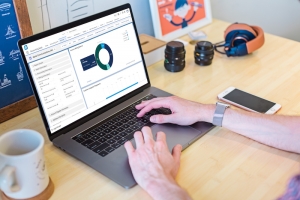عرض العناصر حسب علامة : الاتمتة
ما الفرق بين محاسبة التكاليف والمحاسبة الإدارية؟
كل من محاسبة التكاليف والمحاسبة الإدارية مخصصان للاستخدام الداخلي من قبل قادة الأعمال. يستخدمه القادة الأذكياء لتحسين عمليات المنظمة وتعزيز النتيجة النهائية.
الروبوتات ليسوا محاسبين!
كُتب الكثير في العام الماضي عن أتمتة العمليات الروبوتية (RPA)، ولسبب وجيه. من خلال تسهيل التكامل الأوسع للأنظمة المالية المتباينة وتطبيقات البرامج، يُعد RPA مزيد من الكفاءة لمؤسسات التمويل والمحاسبة. ولكن هل الروبوتات بديل للمحاسبين كما أثبتت بعض المقالات؟
معلومات إضافية
-
المحتوى بالإنجليزية
Much has been written in the last year about robotic process automation (RPA), and for good reason. By facilitating broader integration of disparate financial systems and software applications, RPA promises more efficiency to finance and accounting organizations. But are robots a substitute for accountants, as some articles have attested? Not by a long shot.
RPA captures, manipulates and interprets transactional data flowing from myriad IT systems and applications, effectively taking these repetitive tasks from accountants. That’s a good thing, as it frees up the accounting staff to become strategic accountants. The “robots” liberate accountants to do what they have longed to do — make sense of the financial data to improve business decisions.
RPA is just the latest iteration in a long progression of F&A software tools designed to improve efficiency and data accuracy, including our own here at BlackLine. RPA extends the automated functionality of ERP systems beyond the range of application programming interfaces (commonly known as APIs) and simple object access protocol, which are used to integrate the ERP system with other IT applications. Instead of the customary weeks it takes to link these systems, RPA pares the time down to a matter of days.
Trends and Technologies Shaping the Future of Tax and Accounting
WOLTERS KLUWER
There are some studies, such as that by the Hackett Group, that suggest that automated tools may lead to a reduction in headcount. But robo-accountants are not actual accountants. Despite the enormous power and promise of digital solutions, there will always be a need for the human connection. Robots may replicate what people do, but they are unemotional, have no intuition and cannot be motivated in a common cause. They’re simply machines making routine work easier and more efficient.
Turning dislocation into transformation
Today’s accountants should not fear automation; rather, they should embrace these tools to become strategic accountants. When machines replace traditional forms of work, they simultaneously open the door to other options. People are liberated to be more creative, engaged and productive. Let the robots handle rote administrative processing. Accountants’ skills are far too nuanced to squander on such tasks.
A case in point is the competitive advantage of extracting deeper meaning from internal and exogenous financial data. The internet is inundated with millions of data sets that may have import in business decisions. Software can narrow the field, but someone has to interpret the data to determine where best to grow the business or pull back.
Accountants can perform this function, filtering and analyzing internal and exogenous business-related data to assist the CFO in making more informed and agile decisions. Armed with the accountants’ analyses, the CFO can make more astute bets on where to invest the company’s capital and where to restrict it.
The office of finance has always been the nexus of financial and other business-related data. In today’s blisteringly fast 24/7 global business environment, where change can happen overnight, this information is a vital currency that can improve market share, reduce strategic risks and widen margins. The problem is that CFOs have relied on purely historical business data in making resource allocation and other financial decisions. Accountants are an untapped resource to help make rapid sense of today’s numbers to ensure the company remains on course to achieve its strategic objectives. If this is not the case, the CFO has an enhanced opportunity to nimbly change direction to seize more profitable business opportunities elsewhere.
Do CFOs require such assistance? You bet they do. In a 2016 survey of 122 CFOs at large companies by Deloitte, the respondents stated that they spend more than one quarter (27 percent) of their time on company strategy. An equal amount of time is devoted to operations, identifying ways to improve organizational efficiency, balance costs and manage issues related to talent. Less than one quarter of the CFOs’ time is focused on traditional finance functions, such as accounting and financial reporting and control requirements.
أهم 7 قضايا يواجهها المحاسبون
لكل مهنة تحدياتها الفريدة وبالطبع مهنة المحاسبة مليئة بالتحديات لذلك دعونا نلقي نظرة على أهم 7 قضايا يواجهها المحاسبون اليوم وكيفية التغلب عليها.
معلومات إضافية
-
المحتوى بالإنجليزية
Every profession has its unique challenges. The accounting industry is no different. Let’s look at the top 7 issues accountants face today and how to overcome them.
CHALLENGES ACCOUNTANTS FACE
Are Accountants Still Relevant?
Yes, accountants are still relevant, but the profession is definitely changing. Precipitated by the increased use of cloud accounting technology, accounts are becoming even more technical. Today, the modern accountant is chiefly an advisor, which is the greatest value of this position. Because technology is making things like data entry, bank reconciliations, and billing way more streamlined, this means less focus on entering numbers.
Instead, automated accounting tools give accountants more to analyze and report these numbers. Accountants are actually going to be in higher demand for their value in helping companies make stronger, effective business decisions. Many accountants find success in three main career directions, which you can learn about in our recent webinar, but there are still challenges and issues accountants face. Staying relevant and powerful as an accountant requires adaptability.
Top Issues Facing the Accounting Industry in 2022
The biggest issues accountants face will range individually of course, but much of it will involve technology and growing competition.
Follow along for 7 of the biggest threats and issues to the accounting profession, as well as some insights on how you and your accounting department can best overcome these challenges.
1. Lack Of IT Literacy in the Accounting Field
If you’ve been following accounting current events, the role of an accountant has steadily grown more technical. So much so that failure to adapt to cloud technology could pose a serious threat to an accountant’s job security. Now more than ever, cloud-based accounting systems are being used both in the office and remotely. Finances are going fully digital. One of the biggest challenges accountants face is being able to use cloud accounting software and operate efficiently in a cloud environment. The importance of storing and analyzing financial data from multiple business applications is also playing an increased role. Defining which business tools need to communicate to the accounting solution and what data needs to be monitored is critical for a complete financial picture of the business.
For more details on why IT implementations in accounting departments go poorly so regularly, read on in the Why Accounting IT Implementations Fail guide.
2. Accounting Automation
Related to technology, automation is going to be a challenge for accountants, but not in a way that will eliminate their profession. Automation and even AI will not replace but actually enhance the accountant’s role if they can successfully deploy and use these tools. One of the big challenges for financial experts is being able to harness more automated functions to enhance the value of accounting processes.
To learn more about how to leverage accounting software to automate, read on in our Top 13 Benefits of Automated Accounting and What is Accounting Automation Post-COVID-19 guides.
3. Changing Client Relations For CPAs And Accounting Firms
Competition is always a challenge for financial experts, whether they’re solo Certified Public Accountants (CPAs) or accounting firms. With companies’ resources stretched following the business setbacks of COVID-19, they need accurate accounting insight and a smooth experience.
Developing customer loyalty based on positive client experience is critical. Not only will this help accountants provide better, more effective service, it also strengthens the customer bonds. To overcome this, accountants will need accounting features that improve customer experience.
4. The Accounting Profession Has New Skill Requirements
In addition to new technology requirements and pure accounting knowledge, accountants are facing a much more interconnected world. This means wearing multiple hats to understand how the financial picture is drawn. Specifically, this means becoming more adept in understanding business requirements, processes, and even customer behavior. Today the accountant is less about bookkeeping and more about data analytics.
In an uncertain economy, businesses need accurate, informed financial insight to save money and make the best decisions possible. Financial forecasting, financial analysis, and cash flow projection proficiency are critical skills to have now. The more proficient accountants are in these skills, the more valuable they become. Additionally, being able to create dynamic financial and business reports that answer exactly what the company needs to achieve key objectives are important.
Learn more about how Financial Dashboards can help.
5. Tax Laws are Ever Changing
A constant challenge for accountants is keeping up with tax regulations. All levels of accountants and CPAs should be mindful of changes and be able to use accounting technology and tax management systems to handle taxes online. Digital tax requirements like the UK’s Making Tax Digital (MTD) are growing across the world. Therefore, it’s important for accountants to be familiar with the tech and strategies involved.
With tax accounting software, the software is built to be compliant, meaning you won’t need to spend time considering government regulations. You’ll also save time on calculating sales tax, as it is automatically as transactions are completed.
6. Rising Competition In The Accounting Field
Competition poses a threat to those in the accounting profession. Accounting departments in companies seem to be shrinking in favor of external accounting services. Many accounting agencies also concentrate on specialized accounting skills like financial analytics and nonprofit accounting.
To keep up with your competitors, consider using accounting software to automate workflows related to previously tedious tasks like billing customers and paying vendors. Freeing up time will allow you to focus on keeping your current clients happy, and growing your client list.
7. Keeping Financial Data Secure
Internal and external accounting system threats like ransomware attacks are very prominent and will only pose a more serious threat in the future. Significant hacking and fraud incidents have been steadily increasing, with spikes since the workforce went remote during the COVID-19 lockdowns. For accountants, the challenge is implementing processes and tools to protect data. Remember, accounting errors and data theft have caused many businesses to actually fail. However, while these digital challenges remain, the advantage for accountants is in knowing the features and internal controls needed to protect financial data.
To prevent having your accounting data stolen from cyberattacks, learn more about how cloud-based accounting software can ensure data security by downloading our Free Guide to Financial Security: Accounting Systems.
Get Ahead With The Right Accounting Platform
Whether you’re an individual accountant or accounting firm, you will thrive or struggle based on your accounting system. When you search for a solution, really consider how it will let you collect, visualize, and analyze financial data. Your system should help them do your job without skipping a beat and be flexible in a way to help your function and draw financial insight however you need. Here are a few key considerations when looking for the best accounting system for accountants to utilize.
Does the system provide an audit trail function to track specific information?
Is the accounting platform easy to use and adaptable to business needs?
How efficient are accounting processes?
What’s the level of automation?
How flexible and robust are the reporting features?
Are there security features that fully protect the data?
متى سيكون لدينا أتمتة محاسبية؟
لقد تقدم عالم المحاسبة ومسك الدفاتر كثيرًا عبر التاريخ. على سبيل المثال، كان آخر ابتكار في المحاسبة هو إنشاء إمساك الدفاتر ذات القيد المزدوج. كان ذلك قبل أكثر من 500 عام! الآن، إنه عصر الأتمتة، وأتمتة المحاسبة هي إحدى الصناعات الرائدة.
معلومات إضافية
-
المحتوى بالإنجليزية
When Will We Have Accounting Automation?
Jul 11, 2019 | Salesforce & IT Admins
facebook sharing buttontwitter sharing buttonlinkedin sharing buttonsharethis sharing button
The accounting and bookkeeping world has progressed so much throughout history. For instance, the last innovation in accounting was the creation of double-entry bookkeeping. That was over 500 years ago! Now, it’s the age of automation, and accounting automation is one of the forefront industries.
Accounting automation focuses on the entire accounting lifecycle, not just one part of financial management. As a result, the entire accounting process, the capturing, manipulating, and interpreting of transactional data, is done by software, with less dependence on manual transactional entries by people.
In this blog, we highlight the different types of automation. Also, we’ll answer the question, when will we have accounting automation?
a man on his laptop wondering when will we have accounting automation
Accounting Automation Today
In Accounting Today, Therese Tucker describes robotic process automation (RPA) as a system to manage transactional data flowing from a myriad of information technology (IT) systems and applications.
RPA reduces the time spent performing repetitive tasks. In other words, it links them to data analytics and artificial intelligence to perform other work.
To clarify, these technologies mostly automate high-volume, repeatable tasks, and mimic human actions.
These can be IT process automation (ITPA) and robotic process automation (RPA).
Therefore, this opens up the possibility that machines have the potential to augment (and perhaps replace) the work of humans in tasks.
Today, at several large companies like NBCUniversal, accounting automation is fully underway in the finance department. In fact, automation already assists accountants and financiers in their analysis of the company. The automation is mostly deployed in cash applications and invoice creation for international orders to cash. Bob Kurpershoek, Director of Finance at NBCUniversal says: “The volume is high, and the process is quite standardized. A combination of these two makes the return on investment of putting a robot in place very positive.”
It’s Time to Prepare Now
Today, companies are lining up to get their hands on new technologies that will impact their bottom dollar. Capgemini, a global leader in consulting, technology services, and digital transformation, labeled automating the back office as one of the quick wins to automation. A quick win means it’s not only easy to implement, but also has a high benefit upside.
For example, based on a survey of more than 400 business owners by Acountex and CPATrendlines, IT budgets are up from 75 percent. In summary, these companies are spending their money on audit and risk support, sales tax, and accounting software systems.
When Will Accounting Be Automated?
Software like Accounting Seed is leading the way in delivering accurate, streamlined financial management and access to real-time data to make better decisions faster. But, does this eliminate the human factor? In addition, will accountants be replaced by robots? The answer is, not at all. Automated accounting software simply helps businesses and financial professionals to do their job more efficiently. When users automate repetitive accounting processes, it gives accountants the freedom to focus on being the critical advisors that help steer the organization to new heights.
Accounting Automation and Connectivity
Accounting Seed is powered by Salesforce. This means that our product works seamlessly with the Salesforce platform. In fact, with 400 reviews, Accounting Seed is the top-rated accounting solution on the Salesforce AppExchange. Our users are able to integrate with the Salesforce CRM. This gives Accounting Seed the power to connect to any of Salesforce’s Ready Apps. Most importantly, this enables our product to seamlessly draw data from any type of business solution your company may need with our easy click, no-code integration.
Conclusion
In conclusion, when you look at the money spending habits of leading companies in 2019, it’s apparent that the best way to go about preparing your company for the future is to invest in accounting automation. Automated financial management is becoming more and more prominent as a way for companies to enhance their strategic positioning.
Take a look at the big picture. Through faster, more in-depth accounting you empower your entire organization.
Accounting Seed helps your business reach new heights through the use of our innovative, transformative software. Whether it’s the power of our flexible API, the capability of our automated reporting feature, or the instant access to our cloud-based software, we want our users to realize the benefits of working with an automated accounting solution.
نصائح حول الانتقال الوظيفي لـلمحاسب القانوني ومتخصصي الضرائب
اليوم وبعد مرور أكثر من عام على انتشار الوباء، يشهد الاقتصاد تقدمًا وقد اقترب موسم الضرائب من نهايته، وقد يكون العديد من المحاسبين مستعدين للبحث عن فرصتهم الوظيفية التالية.
معلومات إضافية
-
المحتوى بالإنجليزية
Given the new landscape, CPAs and other tax professionals may ask what steps can you take to grow your career and land your next opportunity.
Now that we’re more than a year into the pandemic, tax season has (finally) come to a close, the economy is on the upswing and many accounting professionals may be ready to search for their next opportunity. Here are a few ways CPAs and tax pros can plan their next move.
Sign up for our FREE email newsletter
Don't miss out on our best content.
Enter email address *Enter email address
Sign up
Education is Key
It may seem basic, but education and attaining credentials go a long way in the accounting profession. Those aspiring to explore a new role should consider the education and certification requirements of their chosen path.
For many professionals, getting their CPA license is a goal and part of the natural career progression. Obtaining this certification can qualify you for many different career opportunities, from within an accounting firm to leading a business across industries, as well as to help you stand out to employers and industry recruiters.
Easily File and Deliver 1099 and W-2 Forms Online
Efile4Biz offers all-inclusive print, mail and e-file services for quick, efficient and secure e-filing of 1099 and W-2 forms. Everything is done online, eliminating the need for software or paper forms.
Get started today!
Depending on your long-term goals, you might consider the CMA (Certified Management Accountant), a global certification for management accountants and finance professionals, or working towards your CGFM (Certified Government Financial Manager), a professional certification awarded by the Association of Government Accountants (AGA) that demonstrates competency in skills like governmental accounting at the federal, state, and local levels. Not only do additional certifications give you an advantage on other job applicants but pursuing them ensures that you’re consistently up to date on the latest information and increases your knowledge base.
And the education doesn’t stop there. In today’s job market, a huge differentiator is knowledge of the latest technology, including the cloud, AI and automation, and practical applications for your role. More and more companies are adopting these technologies and weaving them into everyday processes.
As a result, the need to upskill or reskill has dramatically accelerated. By getting ahead and educating yourself on these hard skills like data analysis and ERP adeptness, it’s possible to stand out among a sea of applicants.
Attend Events (Virtually)
Prior to COVID-19, it may not have been feasible to attend an event or conference, due to cost or lack of time travel. This meant that there were fewer opportunities for less experienced or more junior associates to grow and network with industry thought leaders.
Today, attending events looks a little different. In lieu of traditional conferences, many organizations have switched to virtual platforms – making professional development or networking opportunities more accessible for many. By signing up and learning from thought-provoking industry executives, you can gain insights on the future of the industry and what companies are looking for in the leaders of tomorrow.
Attending virtual events is also a great way to network with peers. Many conferences offer scheduled breakout rooms, giving you the opportunity to engage and participate in discussions with peers and industry leaders. Topics may vary, but sharing your insights and ideas could position you as an expert.
Another way to network virtually is to be active on social media. Consider posting your thoughts and what you hope to experience at the event, using specific hashtags and posting on the event page or your own social media channels. By doing so, you have the ability to spark great conversation with other potential attendees and industry peers and to build your own professional network.
After the event takes place, you can also share lessons learned – this could take the form of a social media post or written article that can be shared on platforms like LinkedIn. There is also an opportunity to share your learnings with members of your firm, which with further exemplify your leadership skills.
Continuing To Develop Your Leadership Role With EQ
Many companies have changed the way they hire and onboard employees because of COVID-19. Prior to the pandemic, leaders may have only been assessed by their hard skills, like developing efficient financial reporting methods. But now the leadership profile has taken a turn, focusing on behavior training and a high emotional intelligence (EQ).
In order to take the next step in your career, it’s critical to focus on your emotional intelligence. Leaders in today’s climate need to be able to better connect with teams and employees, as many people want to work in a place where they feel safe.
When looking for a new career or position, you should be prepared to discuss specific moments in time that highlight instances when EQ and ability to connect with others helped move a situation forward.
While this is a skill that’s typically intrinsic, it is possible to develop your EQ through behavior training, practicing self-awareness and actively listening. Today, these are the skills that matter most in the workplace.
Conclusion
While many employers provide professional development and training resources to their employees, it is important that you take your future into your own hands. Immersing yourself in outside learning opportunities, like virtual events, and continuing to educate yourself on the industry and necessary skill sets relevant to today’s times are critical to advancing your career.
When looking to take that next step, make sure you show recruiters your efficiency in hard skills – like those that come with certifications – and knowledge of technology. Second, but equally as important, show them the soft skills that make you stand out from other applicants – like your willingness to stand up and share lessons learned and the ability to connect with fellow employees at all levels.
أنواع نظم محاسبة الأتمتة التي تحتاجها
يريد الجميع أن تكون حساباتهم أسرع ودقيقة وأسهل. مفتاح ذلك هو الأتمتة. إن توافر ومرونة وظائف الأتمتة للحل الخاص بك ليس فقط وسيلة مريحة ولكنها مهمة لمساعدتك في إدارة متطلبات العمل المتزايدة. دعونا نلقي نظرة على ثلاثة أنواع من الأتمتة يجب أن يتمتع بها حل المحاسبة المحتمل الخاص بك.
معلومات إضافية
-
المحتوى بالإنجليزية
Top 3 Types of Automation Accounting Systems Need
Automating key business processes has significant advantages. Within accounting, you’re looking at a faster, more streamlined financial management process. In a business world that’s not only rapidly changing, but also heavily data-driven, time is money. These core automation will take your accounting process from tedious manual labor to a simple button click.
Event Automation
Transactional accounting is now more streamlined and easier because accounting platforms can fully automate repetitive entries for you through event automation. For example, Accounting Seed utilizes click-not-code automation which enables you to do multiple functions with just a button click. The simpler automation is to implement, the more efficiency you gain. Event-related automation also lets users accomplish multiple tasks simultaneously. This reduces your manual labor while enhancing your entire system’s accuracy.
Batch Automation
Batch automation, or batch processing, is automation in which the system completes batches of jobs at once instead of forcing you to do each job individually and manually. Batch automation lets things like revenue recognition and billing be done in mass to save you time and meet deadlines. You can also run multiple batch operations sequentially according to your defined processes.
Scheduled Job Automation
Scheduled job automation ensures that your accounting never falls behind for you or your customers. Processing jobs manually always carries risks of delay or errors. Recurring jobs create consistency and help you to meet financial deadlines. You should be able to automate daily, weekly, or even monthly cycles as you need. Once set, these can be easily adjusted to reflect new changes to billing or revenue cycles. One click of a button can become multiple tasks delivered exactly when you want. All these automated features let you and your team spend less time entering numbers and more time analyzing them. Remember, these also ensure you have accurate data to make better, faster business decisions in real-time.
لن تحل الأتمتة محل المحاسب القانوني
معلومات إضافية
-
المحتوى بالإنجليزية
Automation won’t replace CPAs. It will enhance them
By Snehal Shinde
November 24, 2021, 10:36 a.m. EST
4 Min Read
Facebook
Twitter
LinkedIn
Email
Show more sharing options
Artificial intelligence is going to change accounting, but not in the ways that you think.
By now, AI is being utilized in almost every industry. While in some sectors automation could lead to a reduction in the number of jobs, for accountants, its impact is beneficial. If you’re a practicing CPA, rest easy; technology isn’t coming here to take your job, it’s here to make your job better.
Like the previous adoption of calculators or online bookkeeping services, the industry, and those who serve in it, are safe. People still provide what technology and algorithms can’t, particularly trust and client interactions. But technology and algorithms can replace much of the work that no one enjoys doing, while simultaneously freeing up CPAs to become better partners to the organizations they work with.
Streamline the collection process of organizer information with SafeSend Organizers™
Introducing a new optional feature within the award winning SafeSend Suite that automates the front end of the tax engagement
SPONSOR CONTENT FROM SAFESEND
Eliminating the mundane
Whether you’re an accountant just starting out or higher up the ladder, you know that many of the tasks for a new accountant are repetitive and boring. But they need to be done. Items like data entry, reconciliation, adjusting entries and categorizing expenses have long been the responsibilities and bane of the newly employed accountant. Few, if any, enjoy this work.
AI in accounting is significantly reducing — and in some cases eliminating — these tasks. That doesn’t mean less experienced accountants are now replaceable. A person is still needed to verify there are no unintended errors in the data. Someone still needs to make sense of and explain all the data. It means less copy and paste during your workday, not a reduction in hours.
Increased accuracy and efficiency
Many repetitive tasks are prone to human error. When you’re plugging in data all day, it’s understandable: Sometimes a keystroke is missed or an item gets duplicated or put on the wrong line in a spreadsheet. Automating these tasks actually increases the accuracy of reports, while drastically reducing the amount of time necessary to compile them.
Imagine spending an hour each day to verify the numbers, rather than four hours just plugging numbers in. Month-end closing reports can take a couple of hours to analyze rather than 20 to compile. When this type of work is automated, it allows accountants to focus on other types of work, often more creative and strategic.
More, happier clients
Increased efficiency and accuracy have trickle-down effects that boost your bottom line. Accounting practices are limited in the number of clients they can take on based on the amount of time required to input data and create reports. Accountants know there’s no shortage of people looking for their skill sets. With the mundane and time-consuming tasks out of the way, you can actually increase your client base.
It also means you can give more time to each client. Rather than emails piling up and having clients beating down the door to get information and reports, you’ll be able to respond and provide them with what they need quickly. This also allows you to talk to them about more strategic concerns like spend and income rates, trends across periods, and suggestions for future actions. Combine this level of service with more accurate reports and you’ve drastically improved client relationships at the same time you’re taking on additional business.
Less stress at tax time
April and the months leading up to it can seem like an endless pile of receipts, forms, spreadsheets and transactions to categorize to prepare taxes. AI can help with all of that. We’ve already talked about the ability of AI to eliminate data entry and perform reconciliation, but it can do even more than that at tax time.
Automation can ensure that not only are all of the numbers compiled accurately, but the information is optimized for tax purposes. In the future, it will also be able to scan for any available tax credits and integrate with the IRS submission portal.
Accountants and tax professionals will still be needed at tax time, because a human will still need to verify that the numbers make sense and double-check that the technology did its job correctly. They’ll just be able to take on more clients, achieve a bit more balance, and get a better night’s rest during crunch time.
Trust still comes from humans
Automation isn’t here to replace accountants. In fact, AI in accounting is designed to benefit from humans, rather than being standalone. It will shift the nature of your daily tasks, with junior accountants performing more strategic, creative work and senior accountants having more client interaction. In the end, the financial professionals that we work with are more than happy with these changes.
Financial professionals are increasingly relying on technology to help run their practices and perform their duties. The breadth of continuing professional education courses that teach tech solutions is evidence of this. AI is at the forefront of new technology for the industry, and adopting it early will give you an advantage as the industry and client expectations shift. - البلد الأردن
أدوات التحويل الحاكمة
مع اعتماد المزيد من المؤسسات للتحليلات والأتمتة، يمكن للمدققين الداخليين المساعدة في تقييم المخاطر وإنشاء إطار عمل للحوكمة.
معلومات إضافية
-
المحتوى بالإنجليزية
Governing Transformative Tools
As more organizations adopt analytics and automation, internal auditors can assist in assessing risks and establishing a governance framework.
Gregory Kogan, Daniel Gaydon, and Douglas M. BoyleOctober 14, 2021Comments
Competitive excellence demands the implementation of data analytics and automation technologies, such as robotic process automation (RPA) and self-service data analytics. These technologies allow organizations to collate and analyze data from massive data sets that are too large to compile in database and spreadsheet applications. In some cases, they can download a trial version and quickly build databases.
Applications like this have driven global organizations to increase their investments in data analytics and automation technologies to streamline repetitive manual processes into powerful and effective automated processes. Annual worldwide spending on RPA technology is projected to grow from $3.6 billion to $42 billion over the next five years, according to Zinnov, a global management consulting company based in Bangalore, India.
Yet, while intelligent automation can provide significant financial and operational benefits, it also can cause considerable reputational, regulatory, financial, and operational damage when it goes wrong. For example, if automation is left unattended, it could lead to errors in critical processes that affect accounting and financial reporting outputs. Internal audit can assist executives and the board in assessing these risks and establishing a governance framework in anticipation of exponential organizationwide adoption of automation and analytics applications.
MEASURING ROI
The driving force behind investments in process automation lies in the potential for realizing large annual cost savings, especially when these technologies are scaled throughout the organization. “For a mid-table Fortune 1000 organization with around $20 billion in revenue and 50,000 employees, automating 20% of estimated addressable activity through RPA could result in $30 million of bottom-line impact each year,” Deloitte reports in The Robots Are Ready. Are You?
C-level executives responding to a 2020 Protiviti survey say the biggest benefits of process automation include increased productivity, better quality, stronger competitive market position, higher customer satisfaction, greater speed, and employee satisfaction from elimination of mundane tasks. However, respondents report encountering obstacles such as inability to prioritize potential RPA initiatives, concerns about cybersecurity and data privacy, high implementation costs, difficulty in scaling applications, and making a convincing business case.
While the development time of RPA projects typically ranges from several weeks to a few months, self-service data analytics projects can be deployed even faster. Simple processes can be automated within a few hours or a few days.
Traditionally, return on investment (ROI) on automation is measured by how many hours are saved. Both RPA and self-service analytics have demonstrated high ROI, when comparing resources invested in the automation projects to the value returned through capacity creation and efficiency. Value is realized by redeploying employee hours saved elsewhere, contributing to organizational productivity (see “Capabilities of RPA and Self-service Data Analytics” below).
ASSESSING RISK
To maintain risk transparency, it is essential for internal audit to create a risk-scoring mechanism that assesses each automation project based on applicable risk dimensions. Starting with the model risk methodology Allan Sammy describes in his June 2018 Internal Auditor article, “Auditing Analytic Models,” his scorecard can be expanded to include key metrics specifically pointed toward automated accounting and finance processes:
Complexity. If the automation deployment is more complex in terms of processing steps, technologically, or is specialized/customized in a way that makes it more intricate, these deployments score higher on the complexity scale.
Economic loss. An increased level of precision is required when failure could result in a direct or explicit economic loss to a client or counterparty.
Consumer. Regulatory risk will be higher if the automation deployment produces outputs for reports that are intended for external regulators and will be audited
or examined.
Success rate. A historical computation compiles the success rate of the automation run over a prescribed reporting period, such as a month, quarter, or year.
Dependency. When automation deployments produce outputs that serve as inputs into other automation deployments, dependency is higher, because an error in this type of automation will permeate other processes.
“Risk Assessment of an Automated Process” (below) is an example of how a scorecard can be applied in an accounting or finance department. Each unique automation deployment risk is scored according to five dimensions unique to the automation environment of those functions. Internal auditors can use this method to assess the risk of each individual automation project deployment, which is usually related to a specific process such as a bank reconciliation.
Because each automation deployment has a different degree of risk related to complexity, economic loss, ultimate consumer, success rate, and dependency, each project will carry a risk score across these five dimensions. By documenting the total risk of individual projects and their related processes, internal auditors can provide management with risk transparency over the automation portfolio and design risk responses strategically.
GOVERNING THE DIGITAL ENVIRONMENT
As companies deploy automation and analytics to accelerate routine processes and create efficiency, the biggest threat to success in scaling these programs is the lack of governance over the risks and controls in this new digital environment. Many organizations that have embraced digital transformation may still be operating under fragmented legacy governance structures that have failed to keep pace with the growth in data analytics tools. Worse yet, governance may be an afterthought, even as build after build propagates dependency after dependency, incrementally adding risk to the data analytics portfolio.
This governance vacuum is compounded by a regulatory gap. For example, in the highly regulated world of accounting and finance, currently there is a lack of specific regulations or guidance on how to establish stable governance and internal controls for automated processes.
Companies are subject to a variety of regulations and governance frameworks such as Section 404 of the U.S. Sarbanes-Oxley Act of 2002, The Committee of Sponsoring Organizations of the Treadway Commission’s Internal Control–Integrated Framework and Enterprise Risk Management–Integrating
With Strategy and Performance, and the U.S. Federal Reserve Data/Model Governance framework. Each mandates that internal controls be effective, risks be managed, and quality of data inputs be high. However, existing laws and frameworks fall short of offering specific guidelines on how to assess the added risks that arise from operating in this new, automated processing environment. Internal audit can lead the governance effort over analytics and automation programs by focusing on three areas.
Training on Analytics and Automation Capabilities Internal audit can contribute to effectively auditing and mitigating risks in the automation and analytics environment by understanding these tools and their capabilities. This includes ensuring that training and development in this area are available throughout the organization.
Leading Through the Analytics and Automation Governance Committee The governance of analytics and automation programs usually occurs through an automation center of excellence or multidisciplinary governance committee. Internal audit should interface with these functions and take a leadership role in overseeing deployments of these technologies. This can enable internal audit to ensure that appropriate internal controls and end-to-end process assurance are embedded into the deployments from the onset.
Identifying High-ROI Analytics and Automation Opportunities Internal auditors can leverage their deep knowledge of organizational processes to advise management by identifying high-ROI analytics and automation opportunities throughout the organization, which can be challenging to find. By taking this proactive role, internal audit can contribute to the success of scaling the analytics and automation.
كيف يقوم أحد برامج المحاسبة بتعريف الطلاب على تقنية أتمتة العمليات الروبوتية RPA؟
معلومات إضافية
-
المحتوى بالإنجليزية
March 9, 2021
Get started with robotic process automation
December 8, 2020
9 tips for teaching data analytics
TOPICS
Accounting Education
Technology
Emerging Technologies
Bryant Richards knew little about robotic process automation (RPA) when accounting firms recruiting at his school, Nichols College in Dudley, Mass., began saying his students should learn the skill. The push led Richards, an associate professor of accounting and finance, to learn more about RPA, and then to create RPA internships, advocate for the inclusion of RPA in the business core curriculum, and conceive of the college’s Center for Intelligent Process Automation. Richards talked with Extra Credit about how and why to incorporate RPA into accounting programs, and how students react to learning this emerging technology.
How did you first get into robotic process automation?
Richards: It started with our stakeholders, such as trustees, alumni, and employers, saying, “Your students need to have RPA,” and I said, “What’s RPA?” They gave me quick insight into it. It took me two years of research and studying and practice to get myself up to speed.
Why is there so much buzz around RPA right now? Why do you prefer the term “intelligent” process automation to “robotic” process automation?
Richards: With RPA, you are recording instructions that enable a system to repeat digital tasks. Anything digitized that you can do with a computer can, for the most part, be recorded in the form of instructions, and that’s not necessarily new. What’s new about this is that now average users can easily learn how to do it and create powerful automations.
The “intelligent” part comes in when you add artificial intelligence that allows you to explore certain things with prebuilt analysis, to do types of complex analysis such as sentiment analysis. What I think we’ll see in the future is a lot more deployment of artificial intelligence where things will get a lot more, dare I say, intelligent and advanced.
Why is it important that accounting students learn about RPA?
Richards: The big accounting firms all say RPA is something they’re training their folks to understand and use now. They’re sending the message that, if students learn how to do this, it would be very useful to them in their careers. Larger companies are also starting to send that message.
Teaching RPA is a brilliant way to help students experience difficult-to-teach accounting concepts, even if they never end up using it in their careers. When trying to create a “bot,” or software robot, that performs a reconciliation, students explore all the facets of that reconciliation, and it really encourages them, if not forces them, to learn it a new and deeper way. They never forget it [after that].
How do you integrate RPA into your accounting curriculum?
Richards: As of this semester, we introduced one week of RPA training into every one of our introductory information technology classes. Every student who goes through our business core will be exposed to RPA.
We also offer research associate internships, in which students advise companies. Twenty students have completed the internships over three semesters, and I expect to turn the internships into a course in the future. We get students building bots, and we slowly pull the training wheels off and get them doing deep analysis. Usually, by the end of the semester, I’m having them work with a client or solve a problem.
Do students struggle with RPA, or do they pick it up easily?
Richards: At least half the students are apprehensive, if not scared, to start with. Once they get through creating their first four bots, they start getting excited, especially if their bots work. Toward the end of the semester, they feel empowered and they can’t believe what they can do with it.
The accounting students are feasting on this [technology]. For some reason it comes more naturally to them.
Can you give me some examples of “bots” accounting students have created?
Richards: A large bank would dump applications into an Excel file which needed to be typed into another system. A student created a bot that simply read the files and punched the data into the bank’s software program. I’m pretty sure it saved the bank a significant amount of money.
Another student worked for a small public firm, and his role was to go to restaurants and do their accounts payable every week. He saw how that process could be automated. His bot saved him 5 to 6 minutes per client, and he had 30 to 40 a week.
Which software do you have students use?
Richards: We used UiPath, software that is fairly user-friendly and provides a lot of training and academic support. They gave us a free community license.
We recently signed an agreement with NICE Systems to have them be our provider of software in the future. The partnership agreement with NICE gives us the ability to leverage their software for Nichols College while we teach our students.
What advice would you give faculty members who are new to RPA about incorporating it into their classes?
Richards: This technology is coming, and they should be up on it. They are more than welcome to reach out to me.
To understand it, you really need to build a bot. UiPath and NICE have some nice starter training courses that can help you create a quick bot on your own.
I think as faculty we feel like we have to learn stuff before we teach it. But you don’t have to be an expert at RPA to roll it out to students and get them exploring accounting concepts with it in a meaningful and valuable way. The tool might be new, but many of us have significant expertise in the related skills.
What is the Center for Intelligent Process Automation?
Richards: The Center for Intelligent Process Automation (CIPA) will focus on three overlapping objectives: adopting technology for Nichols College to become a showcase for higher education; providing thought leadership and support to underserved communities throughout industry and higher education with a focus on improving accessibility; and providing student opportunity and experience, as it will primarily be staffed by trained student workers. We announced the center, in concept, in September 2020 and will release more information soon.
As we did research, we found two primary skills gaps in the accounting profession, one that is tool- and technology-based, and one around the process, data, and architecture skills associated with automation. Nichols College is good at training on business-user tools. We want to tell the profession: We’re going to help with this problem. We’re going to commit resources. We're going to make sure the skills gap shrinks.
The AICPA offers a certificate in robotic process automation. Educators can receive a discount on AICPA certificates.
3 مفاتيح تقنية لتمكين المحاسبين
معلومات إضافية
-
المحتوى بالإنجليزية
3 tech keys for empowering accountants
By Clayton Weir
September 10, 2021 10:43 AM
Facebook
Twitter
LinkedIn
Email
Show more sharing options
Much like every business vertical, accounting has seen its fair share of disruption as a result of the COVID-19 pandemic. And although digital transformation efforts have pushed innovation forward in many industries, accountants, by and large, unfortunately have to deal with fractured processes and outdated tools from pre-pandemic times. Not only do accountants have to tackle daily tasks with antiquated technology, but they have to find ways to make this tech meet the modern demands of today’s financial industry. And as the world around them continues to evolve and modernize, accountants are understandably struggling to keep up.
With that in mind, it is time for banks to allocate more attention and resources toward revamping their accounting infrastructure. Here are a few areas in particular that they need to focus on in order to make this happen.
Cloud migration
technology-and-telecom.jpgWith the number of tools that accountants are forced to deal with on a daily basis, remote work is a nightmare for those who are still forced to work with on-premise infrastructure. Moreover, given a significant portion of the financial industry still relies heavily on this “traditional” technology, on-premise is one of the foremost hurdles that is holding accountants back today. That said, the fix is quite simple: adopt the cloud.
By leveraging a cloud-based infrastructure, businesses can immediately boost the efficiency of their accounting teams by giving them easy, instant access to the data and solutions they need from anywhere. Additionally, it can also make onboarding new tools and processes far less painstaking than doing so with on-premise legacy systems.
Embrace automation
With CFOs and accounting teams now expected to participate more fully in business strategy and other non-finance tasks, the amount of time these teams have to engage in manual tasks continues to shrink. And as such, calls for greater automation within finance departments continue to grow.
According to a guide produced by Sage, 93% of finance workers say they would be happy to have tech do their daily accounting tasks. In addition, as budgets remain tight and workforces are continuously expected to do more with less, empowering accounting teams with automation will be pivotal to business efficiency and overall success.
Choose fintechs wisely
No two finance departments are exactly the same. So it is imperative that businesses take a step back and consider their needs properly before adopting tools and processes. Sure, a tool might seem to make sense on the surface, but what if it actually complicates things or makes tasks more challenging? All too often businesses jump into the fintech pool without fully understanding what their needs are and what they need to solve them.
Accountants have incredibly full plates to begin with. And without the support infrastructure and tools they need to juggle these tasks, it is virtually impossible for them to keep up with modern demands. Therefore, businesses need to work in close consultation with finance teams to identify their most pressing needs and find the solutions that are best tailored to them. Granted, with a global remote workforce, this may seem like a daunting prospect. By getting all of their ducks in a row early, not only will businesses be able to make the onboarding process far easier for their accounting teams, but they will also save valuable time and money down the road.
Accountants are integral to helping businesses achieve financial success. And with that, the time has come for these teams to be supplied with the modern tools that their work deserves. Without it, accountants will continue to struggle to meet their full potential and will not be able to help businesses achieve the growth they are looking for.










